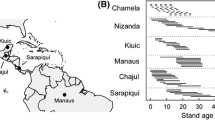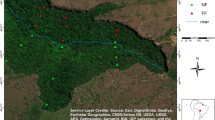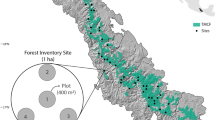Abstract
Tropical forests are paramount in regulating the global carbon cycle due to the storage of large amounts of carbon in their biomass. Using repeat censuses of permanent plots located at 15 sites in the Andes Mountains of northwest Colombia, we evaluate: (1) the relationship between aboveground biomass (AGB) stocks, AGB dynamics (mortality, productivity, and net change), and changes in temperature across a ca. 3000-m elevational gradient (≈ 16.1 °C); (2) how AGB mortality and AGB productivity interact to determine net AGB change; and (3) the extent to which either fine-grain (0.04-ha) or coarse-grain (1-ha) processes determine the AGB dynamics of these forests. We did not find a significant relationship between elevation/temperature and biomass stocks. The net AGB sequestered each year by these forests (2.21 ± 0.51 Mg ha−1 year−1), equivalent to approximately 1.09% of initial AGB, was primarily determined by tree growth. Both forest structural properties and global warming influenced AGB mortality and net change. AGB productivity increases with greater inequality of tree sizes, a pattern characteristic of forest patches recovering from disturbances. Overall, we find that global warming is triggering directional changes in species composition by thermophilization via increased tree mortality of species in the lower portions of their thermal ranges and that the inclusion of small-scale forest structural changes can effectively account for endogenous processes such as changes in forest structure. The inclusion of fine-grain processes in assessments of AGB dynamics could provide additional insights about the effects that ongoing climate change has on the functioning of tropical montane forests.


Similar content being viewed by others
References
Asner GP, Anderson CB, Martin RE, Knapp DE, Tupayachi R, Sinca F, Malhi Y (2014) Landscape-scale changes in forest structure and functional traits along an Andes-to-Amazon elevation gradient. Biogeosciences 11:843–856
Báez S, Malizia A, Carilla J, Blundo C, Aguilar M, Aguirre N et al (2015) Large-scale patterns of turnover and basal area change in Andean forests. PLoS ONE 10:e0126594
Brienen RJW, Phillips OL, Feldpausch TR, Gloor E, Baker TR, Lloyd J et al (2015) Long-term decline of the Amazon carbon sink. Nature 519:344–348
Burnham KP, Anderson DR (1998) Model selection and inference: a practical information-theoretic approach. Springer, New York
Chave J, Condit R, Muller-Landau HC, Thomas SC, Ashton PS, Bunyavejchewin S et al (2008) Assessing evidence for a pervasive alteration in tropical tree communities. PLoS Biol 6:455–462
Chave J, Réjou-Méchain M, Búrquez A, Chidumayo E, Colgan MS, Delitti WBC et al (2014) Improved allometric models to estimate the aboveground biomass of tropical trees. Glob Change Biol 20:3177–3190
Chazdon RL (2008) Chance and determinism in tropical forest succession. In: Carson SA, Schnitzer WP (eds) Tropical forest community ecology. Wiley, Oxford, pp 384–408
Chisholm RA, Muller-Landau HC, Abdul Rahman K, Bebber DP, Bin Y, Bohlman SA et al (2013) Scale-dependent relationships between tree species richness and ecosystem function in forests. J Ecol 101:1214–1224
Clark DA (2007) Detecting tropical forests’ responses to global climatic and atmospheric change: current challenges and a way forward. Biotropica 39:4–19
Clark JS, Bell DM, Kwit MC, Zhu K (2014) Competition-interaction landscapes for the joint response of forests to climate change. Glob Change Biol 20:1979–1991
Condit R, Aguilar S, Hernandez A, Perez R, Lao S, Angehr G et al (2004) Tropical forest dynamics across a rainfall gradient and the impact of an El Niño dry season. J Trop Ecol 20:51–72
Coomes DA, Allen RB (2007) Mortality and tree-size distributions in natural mixed-age forests. J Ecol 95:27–40
Cordonnier T, Kunstler G (2015) The Gini index brings asymmetric competition to light. Perspect. Plant Ecol Evol Syst 17:107–115
Core Team R (2017) R: a language and environment for statistical computing. R Foundation for Statistical Computing, Vienna
Culmsee H, Leuschner C, Moser G, Pitopang R (2010) Forest aboveground biomass along an elevational transect in Sulawesi, Indonesia, and the role of Fagaceae in tropical montane rain forests. J Biogeogr 37:960–974
Cuni-Sanchez A, Pfeifer M, Marchant R, Calders K, Sørensen CL, Pompeu PV et al (2017) New insights on above ground biomass and forest attributes in tropical montane forests. For Ecol Manag 399:235–246
Duque A, Stevenson PR, Feeley KJ (2015) Thermophilization of adult and juvenile tree communities in the northern tropical Andes. Proc Natl Acad Sci 112:10744–10749
Duque A, Saldarriaga J, Meyer V, Saatchi S (2017) Structure and allometry in tropical forests of Chocó, Colombia. For Ecol Manag 405:309–318
Feeley KJ, Silman MR, Bush MB, Farfan W, Cabrera KG, Malhi Y et al (2011) Upslope migration of Andean trees. J Biogeogr 38:783–791
Feeley KJ, Hurtado J, Saatchi SS, Silman MR, Clark DB (2013) Compositional shifts in Costa Rican forests due to climate-driven species migrations. Glob Change Biol 19:3472–3480
Feldpausch TR, Lloyd J, Lewis SL, Brienen RJW, Gloor M, Monteagudo Mendoza A et al (2012) Tree height integrated into pantropical forest biomass estimates. Biogeosciences 9:3381–3403
Fisher JI, Hurtt GC, Thomas RQ, Chambers JQ (2008) Clustered disturbances lead to bias in large-scale estimates based on forest sample plots. Ecol Lett 11:554–563
Girardin CAJ, Malhi Y, Aragao LEOC, Mamani M, Huaraca Huasco W, Durand L et al (2010) Net primary productivity allocation and cycling of carbon along a tropical forest elevational transect in the Peruvian Andes. Glob Change Biol 16:3176–3192
Girardin CAJ, Espejob JES, Doughty CE, Huasco WH, Metcalfe DB, Durand-Baca L et al (2014) Productivity and carbon allocation in a tropical montane cloud forest in the Peruvian Andes. Plant Ecol Divers 7:107–123
Hemp A, Zimmermann R, Remmele S, Pommer U, Berauer B, Hemp C, Fischer M (2017) Africa’s highest mountain harbours Africa’s tallest trees. Biodivers Conserv 26:103–113
Hijmans RJ, Cameron SE, Parra JL, Jones PG, Jarvis A (2005) Very high resolution interpolated climate surfaces for global land areas. Int J Climatol 25:1965–1978
Körner C (2017) A matter of tree longevity. Science 355:130–131
Larjavaara M (2014) The world’s tallest trees grow in thermally similar climates. New Phytol 202:344–349
Lewis SL, Lloyd J, Sitch S, Mitchard ETA, Laurance WF (2009) Changing ecology of tropical forests: evidence and drivers. Annu Rev Ecol Evol Syst 40:529–549
Lewis SL, Edwards DP, Galbraith D (2015) Increasing human dominance of tropical forests. Science 349:827–832
Liang J, Crowther TW, Picard N, Wiser S, Zhou M, Alberti G et al (2016) Positive biodiversity-productivity relationship predominant in global forests. Science 354:aaf8957
Malagón CD (2003) Ensayo sobre tipología de suelos Colombianos–énfasis en génesis y aspectos ambientales. Rev Acad Colomb Cienc 27:319–341
Malhi Y, Girardin CAJ, Goldsmith GR, Doughty CE, Salinas N, Metcalfe DB et al (2017) The variation of productivity and its allocation along a tropical elevation gradient: a whole carbon budget perspective. New Phytol 214:1019–1032
Marshall AR, Willcock S, Platts PJ, Lovett JC, Balmford A, Burgess ND et al (2012) Measuring and modelling above-ground carbon and tree allometry along a tropical elevation gradient. Biol Conserv 154:20–33
Nakagawa S, Schielzeth H (2013) A general and simple method for obtaining R2 from generalized linear mixed-effects models. Methods Ecol Evol 4:133–142
Oliver CD, Larson BC (1990) Forest stand dynamics. McGraw-Hill, New York
Pan Y, Birdsey RA, Fang J, Houghton R, Kauppi PE, Kurz WA et al (2011) A large and persistent carbon sink in the world’s forests. Science 333:988–993
Phillips OL, Baker TR, Arroyo L, Higuchi N, Killeen TJ, Laurance WF et al (2004) Pattern and process in Amazon tree turnover, 1976–2001. Philos Trans R Soc B Biol Sci 359:381–407
Phillips OL, Lewis SL, Baker TR, Chao K-J, Higuchi N (2008) The changing Amazon forest. Philos Trans R Soc B Biol Sci 363:1819–1827
Phillips OL, Aragão LEOC, Lewis SL, Fisher JB, Lloyd J, López-González G et al (2009) Drought sensitivity of the Amazon rainforest. Science 323:1344–1347
Pitman NCA, Widmer J, Jenkins CN, Stocks G, Seales L, Paniagua F, Bruna EM (2011) Volume and geographic distribution of ecological research in the Andes and the Amazon, 1995–2008. Trop Conserv Sci 4:64–81
Prado-Junior JA, Schiavini I, Vale VS, Arantes CS, van der Sande MT, Lohbeck M, Poorter L (2016) Conservative species drive biomass productivity in tropical dry forests. J Ecol 104:817–827
Ramírez JF, Arango DA, Duque A (2015) Thinning effect on Euterpe oleracea population dynamics in the Choco biogeographic region of Colombia. Trees 29:1177–1185
Réjou-Méchain M, Tanguy A, Piponiot C, Chave J, Hérault B (2017) BIOMASS: an r package for estimating above-ground biomass and its uncertainty in tropical forests. Methods Ecol Evol 8:1163–1167
Saatchi SS, Harris NL, Brown S, Lefsky M, Mitchard ETA, Salas W et al (2011) Benchmark map of forest carbon stocks in tropical regions across three continents. Proc Natl Acad Sci 108:9899–9904
Spracklen DV, Righelato R (2014) Tropical montane forests are a larger than expected global carbon store. Biogeosciences 11:2741–2754
Stephenson NL, Das AJ, Condit R, Russo SE, Baker PJ, Beckman NG et al (2014) Rate of tree carbon accumulation increases continuously with tree size. Nature 507:90–93
Sullivan MJP, Talbot J, Lewis SL, Phillips OL, Qie L, Begne SK et al (2017) Diversity and carbon storage across the tropical forest biome. Sci Rep 7:39102
Sullivan MJP, Lewis SL, Hubau W, Qie L, Baker TR, Banin LF et al (2018) Field methods for sampling tree height for tropical forest biomass estimation. Methods Ecol Evol 9:1179–1189
Sumanta B (2007) Relationship between size hierarchy and density of trees in a tropical dry deciduous forest of western India. J Veg Sci 18:389–394
Talbot J, Lewis SL, Lopez-Gonzalez G, Brienen RJW, Monteagudo A, Baker TR et al (2014) Methods to estimate aboveground wood productivity from long-term forest inventory plots. For Ecol Manag 320:30–38
Tilman D (1999) The ecological consequences of changes in biodiversity: a search for general principles. Ecology 80:1455–1474
Tyukavina A, Hansen MC, Potapov PV, Krylov AM, Goetz SJ (2016) Pan-tropical hinterland forests: mapping minimally disturbed forests. Glob Ecol Biogeogr 25:151–163
Unger M, Homeier J, Leuschner C (2012) Effects of soil chemistry on tropical forest biomass and productivity at different elevations in the equatorial Andes. Oecologia 170:263–274
Vandermeer J, Goldberg D (2003) Elementary population ecology. Princeton University Press, Princeton
Venter M, Dwyer J, Dieleman W, Ramachandra A, Gillieson D, Laurance S et al (2017) Optimal climate for large trees at high elevations drives patterns of biomass in remote forests of Papua New Guinea. Glob Change Biol 23:4873–4883
Weiner J (1990) Asymetric competition in plant populations. Trends Ecol Evol 5:360–364
Wright SJ (2005) Tropical forests in a changing environment. Trends Ecol Evol 20:553–560
Zeileis A (2015) Ineq: measuring inequality, concentration, and poverty. R Package. http://CRAN.R-project.org/package=ineq
Zhang J, Huang S, He F (2015) Half-century evidence from western Canada shows forest dynamics are primarily driven by competition followed by climate. Proc Natl Acad Sci 112:4009–4014
Zuleta D, Duque A, Cardenas D, Muller-Landau HC, Davies S (2017) Drought-induced mortality patterns and rapid biomass recovery in a terra firme forest in the Colombian Amazon. Ecology 98:2538–2546
Acknowledgements
A.D. is supported by Agreement 312 established between Jardín Botánico “Joaquín Antonio Uribe” de Medellín and Helvetas Swiss Intercooperation (Peru), which includes the participation of the Universidad Nacional de Colombia Sede Medellín. K.J.F. is supported by the US National Science Foundation (DEB-1350125) and a grant from the Helvetas Swiss Intercooperation. Comments from two anonymous reviewers helped to significantly improve the quality of the manuscript.
Author information
Authors and Affiliations
Corresponding author
Additional information
Communicated by Jan Wunder.
Electronic supplementary material
Below is the link to the electronic supplementary material.
Rights and permissions
About this article
Cite this article
Peña, M.A., Feeley, K.J. & Duque, A. Effects of endogenous and exogenous processes on aboveground biomass stocks and dynamics in Andean forests. Plant Ecol 219, 1481–1492 (2018). https://doi.org/10.1007/s11258-018-0895-2
Received:
Accepted:
Published:
Issue Date:
DOI: https://doi.org/10.1007/s11258-018-0895-2




